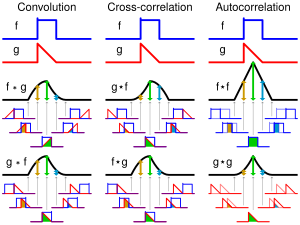What does cross-correlation mean?
Definitions for cross-correlation
cross-cor·re·la·tion
This dictionary definitions page includes all the possible meanings, example usage and translations of the word cross-correlation.
Wiktionary
cross-correlationnoun
A notion used across various fields of scientific study that shows the relation between members of two or more groups of data.
Wikidata
Cross-correlation
In signal processing, cross-correlation is a measure of similarity of two waveforms as a function of a time-lag applied to one of them. This is also known as a sliding dot product or sliding inner-product. It is commonly used for searching a long-signal for a shorter, known feature. It also has applications in pattern recognition, single particle analysis, electron tomographic averaging, cryptanalysis, and neurophysiology. For continuous functions, f and g, the cross-correlation is defined as: where f * denotes the complex conjugate of f. Similarly, for discrete functions, the cross-correlation is defined as: The cross-correlation is similar in nature to the convolution of two functions. In an autocorrelation, which is the cross-correlation of a signal with itself, there will always be a peak at a lag of zero unless the signal is a trivial zero signal. In probability theory and statistics, correlation is always used to include a standardising factor in such a way that correlations have values between −1 and +1, and the term cross-correlation is used for referring to the correlation corr between two random variables X and Y, while the "correlation" of a random vector X is considered to be the correlation matrix between the scalar elements of X.
Numerology
Chaldean Numerology
The numerical value of cross-correlation in Chaldean Numerology is: 4
Pythagorean Numerology
The numerical value of cross-correlation in Pythagorean Numerology is: 6
Translation
Find a translation for the cross-correlation definition in other languages:
Select another language:
- - Select -
- 简体中文 (Chinese - Simplified)
- 繁體中文 (Chinese - Traditional)
- Español (Spanish)
- Esperanto (Esperanto)
- 日本語 (Japanese)
- Português (Portuguese)
- Deutsch (German)
- العربية (Arabic)
- Français (French)
- Русский (Russian)
- ಕನ್ನಡ (Kannada)
- 한국어 (Korean)
- עברית (Hebrew)
- Gaeilge (Irish)
- Українська (Ukrainian)
- اردو (Urdu)
- Magyar (Hungarian)
- मानक हिन्दी (Hindi)
- Indonesia (Indonesian)
- Italiano (Italian)
- தமிழ் (Tamil)
- Türkçe (Turkish)
- తెలుగు (Telugu)
- ภาษาไทย (Thai)
- Tiếng Việt (Vietnamese)
- Čeština (Czech)
- Polski (Polish)
- Bahasa Indonesia (Indonesian)
- Românește (Romanian)
- Nederlands (Dutch)
- Ελληνικά (Greek)
- Latinum (Latin)
- Svenska (Swedish)
- Dansk (Danish)
- Suomi (Finnish)
- فارسی (Persian)
- ייִדיש (Yiddish)
- հայերեն (Armenian)
- Norsk (Norwegian)
- English (English)
Word of the Day
Would you like us to send you a FREE new word definition delivered to your inbox daily?
Citation
Use the citation below to add this definition to your bibliography:
Style:MLAChicagoAPA
"cross-correlation." Definitions.net. STANDS4 LLC, 2024. Web. 19 Apr. 2024. <https://www.definitions.net/definition/cross-correlation>.



Discuss these cross-correlation definitions with the community:
Report Comment
We're doing our best to make sure our content is useful, accurate and safe.
If by any chance you spot an inappropriate comment while navigating through our website please use this form to let us know, and we'll take care of it shortly.
Attachment
You need to be logged in to favorite.
Log In